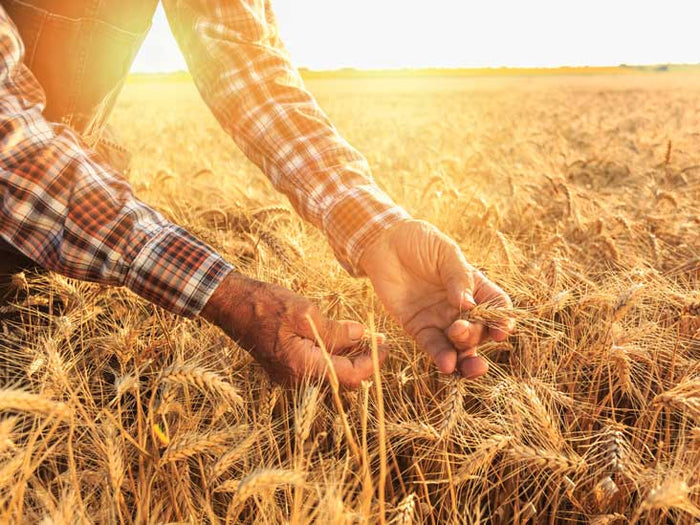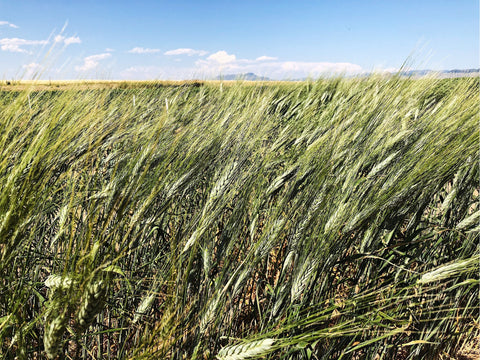We learned about all the benefits of KAMUT® grains right when we started out with our Breadlovers company last year. Clearly, we had to create a bread with this healthy and delicious grain.
Our first creation with KAMUT® flour was the Fall in Love bread baking kit (seasonal Oct-Dec), but we just couldn't get enough of this delicious grain and soon came up with a second creation, our Missoula Nuts bread baking kit (90% KAMUT® Khorasan wheat flour, 10% whole wheat bread flour, chia seeds, and hazelnuts). Our Burnside Loaf (90% KAMUT® khorasan wheat flour, 10% spelt wheat flour, pumpkin seeds) is our newest bread baking kit with KAMUT®.

After doing a lot of research on the KAMUT® story, its health benefits and the people behind the brand, we got more and more curious and excited to finally meet them ourselves.
So we traveled to meet Bob Quinn, the founder of KAMUT® Brand, on his farm in Big Sandy, Montana. I can say, it definitely was a very inspiring day - one of these special moments in life that you will always remember. We feel very honored that we had the opportunity to spend some great quality time with Bob.
On our way to his farm, we drove through some very rural areas, with only a few farms and very small townships, for a couple of hours. Coming from the Portland metropolitan area, where you have shopping opportunities everywhere, we were joking about where people get their groceries and asked Bob right away. He said, "Well, we have everything you need right here on our farm!" We couldn't believe this, so he showed us around. First of all, he presented his family tree with many German ancestors to us, which obviously made us very proud. Then, he showed us his own planted vegetable, herbs, potato cellar, oil barn, fruit trees and of course the fields, where he does a great amount of research with different grains and vegetables.



The story of KAMUT® grains is very special, but the story of Bob Quinn the Organic Farmer is even more extraordinary. In particular, his ideas about nutrition, his thoughts, and concerns on the modern "American Lifestyle", and his visionary thinking on the future of organic farming. Coming from Germany, we were totally overwhelmed with how food in the US is being processed.
The smell in Bob's potato cellar was very familiar for me since my grandmother had one of these years ago. A lot of memories came back when Bob showed us around his farm. Things and smells I had already forgotten because you will not find them in a grocery store where everything is packaged in plastic.
Sitting at Bob's kitchen table time flew by while we enjoyed our freshly baked bread with his home-made fruit spread and honey. Of course, the cherry-apple juice served, was freshly made with fruit from Bob's garden. It was then when Bob told us the story about his journey with KAMUT® grains and how successful KAMUT® has been so far. One of the brand's missions is to keep the grain as ancient as it is and not mix it with any other grains. It should always be planted organically and is limited per farm. Furthermore, we spoke about his upcoming book and its mission. He told us about several of his projects, such as supporting Indian reservations with organic farming and the purchase of his neighboring farm to start a research center for organic farming. With one project following the other, he also told us about his retirement plans in 3 years :-)! I am not sure how this is possible with so many wonderful ideas in mind, but we will see.

On our visit, we learned a lot about organic farming, about the grain KAMUT®, about Bob and his mission to bring healthy food to people's tables and about a man inspiring people and generations in so many fields. We already were super excited about the KAMUT® wheat flour we've been using in our bread baking kits, but after our visit to Montana, we are even more inspired and motived to create additional products and bread varieties with this grain. Our visit has also inspired us to return to the lifestyle I have once learned from my grandmother, to buy organic products on local farmer's markets to support organic farmers, to avoid processed and unhealthy food as well as to be one with the nature around you.
THANK YOU, Bob! It was a real pleasure to meet you and we are looking forward to supporting your mission.
Also, we are very thankful to have met and spent time with Jamie and Trevor from KAMUT® Brand in Missoula, Montana. We learned about the fantastic work they are doing worldwide to protect the brand and its mission.
If you want to read more about KAMUT® Brand - check out this website: https://www.kamut.com/




 Stefanski added, "gluten-free junk food is still junk food. While a gluten-free cookie may not have wheat, it still has calories. In my experience as a registered dietitian, clients normally find substitutes for gluten-containing treats and eventually add back in high-calorie, albeit gluten-free, indulgences."
Stefanski added, "gluten-free junk food is still junk food. While a gluten-free cookie may not have wheat, it still has calories. In my experience as a registered dietitian, clients normally find substitutes for gluten-containing treats and eventually add back in high-calorie, albeit gluten-free, indulgences."







